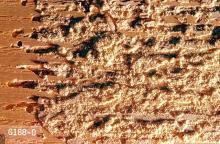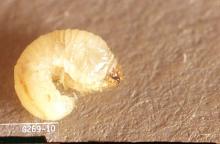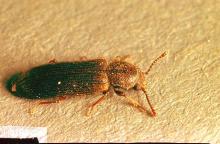Beetles are the most diverse group of insects on earth and yet, only a few species are important as structural pests. Given the long duration that beetle larvae feed within wooden timbers, they can cause extensive damage to houses and commercial buildings.
Ambrosia beetle
Platypodidae
Ambrosia beetles are small, dull brown or black, with compact, cylindrical bodies and short legs. Adult beetles and larvae depend on the ambrosia fungus for food. The fungus requires a high wood moisture content to thrive. Important species in the Northwest are Trypodendron lineatum and Gnathotrichus retusus.
Ambrosia beetles are pests of felled trees and cut logs. The name is derived from the beetle's habit of cultivating fungi or "ambrosia" on the walls of its tunnels. Ambrosia beetles tunnel in the sapwood and heartwood, sometimes producing a bluish stain. True bark beetles also may produce a blue stain effect, but they mine under the bark in the cambial tissue.
Logs are most susceptible for about 3 months after felling. Logs cut in the previous fall through March of the following year are highly susceptible. The greatest attack rates are from mid April to late May.
Pheromone traps are available to help locate infestations, but they are not an effective means of control. Damage may sometimes be prevented by applying an insecticide to logs. However, it can be very difficult and expensive to get adequate coverage. Once larvae start to tunnel, insecticides are ineffective.
Use products with labels appropriate for treatment of felled trees and logs. Check and follow label instructions.
False powerpost beetle
Anobiidae
Most wood-boring beetles found in structures in the PNW belong to the family Anobiidae, the false powderpost beetles. Often, they are mistakenly called powderpost beetles. Anobiids are typically pests of softwoods (e.g., Douglas-fir, hemlock, cedar), but certain species occasionally are found in hardwoods such as maple, walnut, and oak.
The western deathwatch beetle, Hemicoelus gibbicollis, is responsible for most of the beetle-related damage to wooden structures along coastal areas. Although common in older buildings with crawl spaces or basements, their small size 0.13 to 0.38 inch (3 to 6 mm) and dark color means these insects are rarely observed. Any wooden timber with a moisture content of 13% to 18% is subject to attack. Adult beetles lay eggs in cracks and depressions of structural timbers, predominantly Douglas-fir. Upon hatching, larvae bore into wood, produce a pellet-like frass, and may continue to feed for 5 or 6 years or longer. Eventually they tunnel toward the surface, pupate, and emerge as adults during summer. The cycle continues until all available nutrition has been depleted. Often, only powdery frass and a wooden shell are all that remain of a structural timber.
Management of anobiids involves replacing severely damaged wood and eliminating conditions that cause the wood to become moist. Proper ventilation and drainage, removal of wooden debris, and installation of a vapor barrier in the crawl space reduces the likelihood of an infestation.
Sodium borates are highly effective against structure-infesting anobiids. Adult beetles are not repelled by borates and lay eggs normally. Eggs and newly emerging larvae do not survive. However, it may take several years for all existing populations present in an infested structure to ingest a lethal dose of this pesticide. Fumigation is rarely, if ever, necessary for control of structure-infesting anobiids.
Other wood-infesting beetles
Bostrichidae
Damage to woodwork and furniture by this group of beetles consists of round holes about 0.25 inch (6 mm) in diameter made by adults, and irregular, longitudinal tunnels made by the larvae. Larvae are grub-like and somewhat enlarged near the head.
- Black polycaon (Polycaon stouti) attacks any softwood and several hardwoods. It sometimes burrows in the softwood inner panel of certain three-ply veneers. Damage to the inner panel may not be noted until panels have been made into furniture and adult beetles bore out through the veneer.
- Lead cable borer (Scobicia declivis) has the interesting but troublesome habit of boring into electrical cables. Short-circuits may take place when damaged cables become damp.
- Bamboo borer (Dinoderus minutus), is commonly found in bamboo baskets, picture frames, and furniture from Asia. Remove and replace infested materials or, if considering chemical options, have the situation evaluated by a licensed pest management professional.
Flatheaded borer
Buprestidae
Oval emergence holes appearing in siding, flooring, or other parts of a structure indicate activity of one of the beetles in the family Buprestidae, commonly referred to as the flatheaded borer or metallic wood-boring beetle. The first three body segments behind the head of larvae are flattened and enlarged, thus the name "flatheaded." The golden buprestid (Buprestis aurulenta), is the most commonly observed species in this group. The adult beetle is iridescent, gold and green in color, and about 0.5 inch (12 mm) long.
While their tunnels can be fairly large, flatheaded borers pose little threat to structures since they do not re-infest. Larvae mining in certain wood products may require a long period to develop, and so it may appear that an infestation is recurring. There are documented accounts of beetles emerging from wood products, including furniture and lumber used in construction of houses, in which eggs had been deposited at least 15 to 20 years earlier. Most larval mining in houses, and all mining in finished products, is due to infestation prior to manufacture. Kiln-drying kills all stages of the insect in wood. Emergence holes can be repaired, but chemical control is not needed.
Roundheaded borer
Cerambycidae
Adult cerambycid beetles vary in size and color and are identified most readily by their extremely long antennae, which often are longer than the body. Larvae are white, long, slender, and usually legless. Roundheaded borers attack recently cut trees or timbers from which bark has not been removed. Improperly edged lumber, with pieces of bark still attached, may be targeted. In lumber piles, the larvae tunnel from board to board causing heavy damage. Stressed, recently dead, or dying trees are often attacked.
Injury caused by roundheaded borers is characterized by borings that have mixed fibrous and powdery material. The tunnels tend to lie within the annual rings, but this is not always the case. Adult beetles make circular exit holes and these are often the first evidence of an infestation.
Most cerambycids infesting structural timbers in the PNW complete their life cycle in 2 to 3 years and do not re-infest. Chemical control is unnecessary because once the adult beetles emerge, they fly away to more suitable host material found outside of structures.
True powderpost beetle
Lyctidae
The lyctids, or true powderpost beetles, feed predominantly on starch in hardwoods, such as oak, maple, or ash, although they also infest bamboo (a grass). Hardwood flooring, cabinets, trim, plywood, and wooden articles, such as furniture, tool handles, and crates, are commonly infested. Tropical woods from Central and South America, left in storage in the southeastern United States prior to manufacture and distribution, often are attacked by lyctids. These infested products are then distributed to many parts of the country for construction in buildings.
Lyctids generally have a 1-year life cycle. Adult beetles are small, 0.06 to 0.13 inch in length, and red, brown, or black in color. Eggs are laid in pores of hardwoods, and larvae mature over 8 to 10 months. Lyctid damage can be recognized by the powdery frass (much like talcum powder), produced while larvae are feeding, or the circular, pinhead-sized exit holes adults create in order to emerge. To be certain that lyctids, and not some other type of wood infesting pest, are present, consult a licensed pest management professional or your local extension office.
Lyctids have become cosmopolitan in distribution due to the movement of commerce throughout the world. Species found in the PNW include the brown lyctus beetle (Lyctus brunneus), the western lyctus beetle (Lyctus cavicollis), and the southern lyctus beetle (Lyctus planicollis). Control usually necessitates the removal of infested wood or, in certain extreme cases, tent fumigation. To eliminate existing populations, small wooden items can be placed in a walk-in freezer, at or below 0°F, for several days. Sealing all wood surfaces with varnish, shellac, or paint will prevent egg deposition by female powderpost beetles.




